
Caltrain is a California commuter rail line serving the San Francisco Peninsula and Santa Clara Valley. The southern terminus is in San Jose at Tamien station with weekday rush hour service running as far as Gilroy. The northern terminus of the line is in San Francisco at 4th and King Street. Caltrain has 28 regular stops, one limited-service weekday-only stop, one weekend-only stop (Broadway), and one football-only stop (Stanford). While average weekday ridership in 2019 exceeded 63,000, impacts of the COVID-19 pandemic have been significant: in August 2022, Caltrain had an average weekday ridership of 18,600 passengers.

Tamien station is an intermodal passenger transportation station in the Tamien neighborhood of central San Jose, California, served by the VTA light rail and the Caltrain commuter rail line, along with bus connections. The station has two elevated island platforms, one for each service. The two platforms are connected by a walkway at ground-level that is below the two platforms. The light rail platform is located in the center median of the State Route 87 freeway just north of the Alma Avenue overpass. The Caltrain platform is located between Lick Avenue and State Route 87, just north of Alma Avenue.

Downtown Mountain View station is an intermodal transit station providing public bus and rail service, located in Mountain View, California. The station is served by the Caltrain commuter rail service, for which it is simply called Mountain View station. Santa Clara VTA Orange Line light rail service is provided to an adjacent, dedicated light rail facility, known as Downtown Mountain View station. VTA local transit bus and employer-operated shuttle services are accommodated from the Mountain View Transit Center on the Evelyn Avenue side of the station.

Palo Alto station is an intermodal transit center in Palo Alto, California. It is served by Caltrain regional rail service, SamTrans and Santa Clara VTA local bus service, Dumbarton Express regional bus service, the Stanford University Marguerite Shuttle, and several local shuttle services. Palo Alto is the second-busiest Caltrain station after San Francisco, averaging 7,764 weekday boardings by a 2018 count. The Caltrain station has two side platforms serving the two tracks of the Peninsula Subdivision and a nearby bus transfer plaza.

22nd Street station is a Caltrain commuter rail station located south of 22nd Street between the Dogpatch and Potrero Hill neighborhoods of San Francisco, California beneath the Interstate 280 freeway viaduct. The only below-grade Caltrain station, it is bracketed on the north and south by two tunnels which take the line under the eastern slope of Potrero Hill. The station is also served by Muni routes 48 and 55.

Bayshore station is a Caltrain commuter rail station in the Visitacion Valley neighborhood of San Francisco, California. The station is on the border of San Francisco and the neighboring city of Brisbane. The parking lot and the northern section of the station are in San Francisco, while the remainder is in Brisbane. The station address is in San Francisco proper.

South San Francisco station is a Caltrain station in South San Francisco, California. The station is on the east side of the Bayshore Freeway, east and south of the curved Grand Avenue overpass, and north of where the freeway crosses over the tracks. Downtown South San Francisco is to the west, across the freeway. It previously underwent a substantial modernization and expansion project, completed in January 2022.
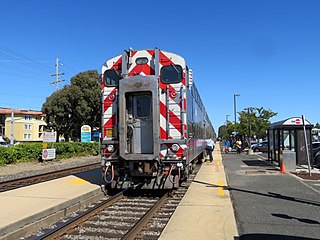
Broadway station is a Caltrain station in Burlingame, California. Caltrain only serves the stop on weekends and holidays; weekday service is provided by a bus shuttle to nearby Millbrae station.
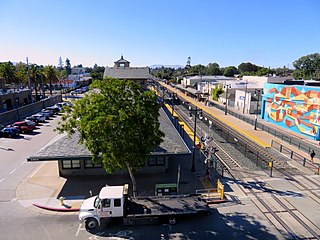
San Mateo station is the northernmost of the three Caltrain stations in San Mateo, California. It is in downtown San Mateo.

Hillsdale station is one of three Caltrain stations in San Mateo, California. The station is next to the Bay Meadows neighborhood and close to the Hillsdale Shopping Center.
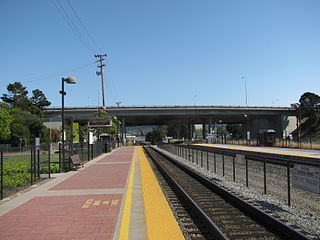
Hayward Park station is one of three Caltrain stations in San Mateo, California. It is located just to the north of the State Route 92 overcrossing, about 1,200 ft (370 m) south of the site of the original Southern Pacific station in Hayward Park. It was relocated in 1999 because of a lack of parking at the original site, and because the previous station had been sited along a curve in the tracks near 16th Avenue. The present station has two side platforms, with at-grade signalized and gate-protected pedestrian/bicycle crossings of the tracks at both its north and south ends.

San Antonio station is a Caltrain commuter rail station located in Mountain View, California. The station has two side platforms serving the two tracks of the Peninsula Subdivision, with a pedestrian tunnel at the south end.
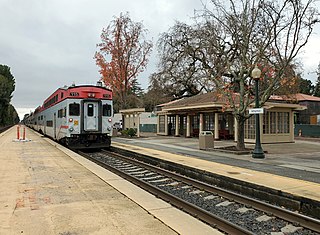
Atherton station is a former Caltrain station in Atherton, California. The station had one side platform and one island platform serving the two tracks of the Peninsula Subdivision, with a concrete and wooden shelter on the west side of the tracks. The station opened by the Southern Pacific Railroad in 1866 as Fair Oaks and was renamed Atherton in 1912. Caltrain cut weekday service to the station in 2005 due to low ridership and a hold-out rule that prohibited two trains from being at the station simultaneously. Weekend service continued until December 2020.

Paul Avenue was a Caltrain station located in the Bayview neighborhood of San Francisco, California. The lightly used station was closed on August 1, 2005, and the platform and shelter were removed in 2009. A replacement station to the north has been proposed.
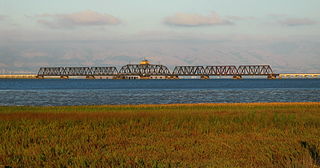
The Dumbarton Rail Corridor is a proposed transbay passenger rail line which would reuse the right-of-way that was initially constructed from 1907–1910 as the Dumbarton Cut-off. The Dumbarton Cut-off includes the first structure to span San Francisco Bay, the 1910 Dumbarton Rail Bridge, although the vintage Cut-off bridges would likely be replaced prior to activating new passenger service. Dumbarton Rail Corridor would provide service between Union City in the East Bay and Menlo Park on the Peninsula, with train service continuing to both San Francisco and San José along the existing Caltrain tracks. It has been in the planning stages since 1988, and would be the first above-ground transbay rail line since Key System electric trains stopped running on the lower deck of the Bay Bridge in 1958, and the first new transbay crossing of any kind since the completion of the Transbay Tube in 1974.

The Caltrain Express (CTX) project was implemented from 2002 to 2004 and led to the establishment of the Baby Bullet express service, which shortened the transit time between San Francisco and San Jose, and certain stations in between. New locomotives and rolling stock were purchased for dedicated express service, bypassing most stations; quad-track overtake sections were added in two locations along the Peninsula Corridor right-of-way to allow express trains to pass slower local trains that were making all stops; tracks were also upgraded with continuous-welded rail; a centralized traffic control system was added; and crossovers were added every few miles to allow single-tracking trains around disabled trains. Congresswoman Jackie Speier, then serving as a California State Senator, is credited with securing the funding for CTX and one of the new locomotives acquired for the project is named for her as a result. During commute hours, the Baby Bullet is up to 20% faster than driving south from San Francisco to San Jose.
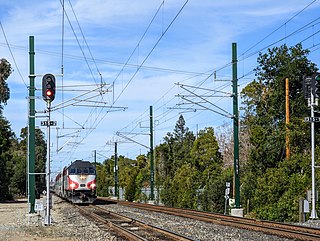
The Caltrain Modernization Program (CalMod), sometimes referred to as the Caltrain Electrification Project, is a $2.44 billion project that will add a positive train control (PTC) system and electrify the main line of the U.S. commuter railroad Caltrain, which serves cities in the San Francisco Peninsula and Silicon Valley, as well as transition from its current diesel-electric locomotive powered trains to electric multiple units (EMU). According to Caltrain, electrification of the tracks will allow it to improve service times via faster acceleration and shorter headways, reduce air pollution and noise, and facilitate a future railway tunnel into downtown San Francisco's Salesforce Transit Center, as diesel trains cannot serve underground stations.
The Downtown Rail Extension (DTX) is a planned second phase of the San Francisco Transbay Transit Center (TTC). When complete, it will extend the Caltrain Peninsula Corridor commuter rail line from its current northern terminus at 4th and King via a 1.3 mi (2.1 km) tunnel. The new terminus will be near the Financial District and will provide intermodal connections to BART, Muni, Transbay AC Transit buses, and long-distance buses. In addition, the California High Speed Rail Authority (CHSRA) plans to use DTX and the Caltrain-owned Peninsula Corridor for service on the CHSRA San Francisco–San Jose segment. Because DTX uses a long tunnel, current diesel locomotives are not suitable and the Caltrain Modernization Project (CalMod), which includes electrification of the line and acquisition of electrified rolling stock, is a prerequisite.
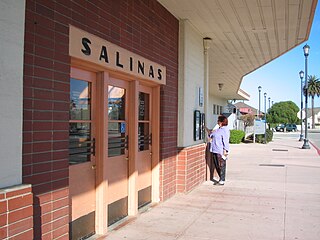
The Monterey County Rail Extension is a planned commuter rail extension that would bring Caltrain passenger service south of its existing Gilroy, California terminus to Salinas in Monterey County, using the existing Coast Line owned by Union Pacific (UPRR). Implementation of the rail extension will occur over three phases, starting from Salinas and moving north. When construction is complete, there will be four trains operated over the extended line per weekday: two northbound trains that depart from Salinas and travel to San Francisco in the morning, and two southbound trains that return to Salinas in the afternoon.























